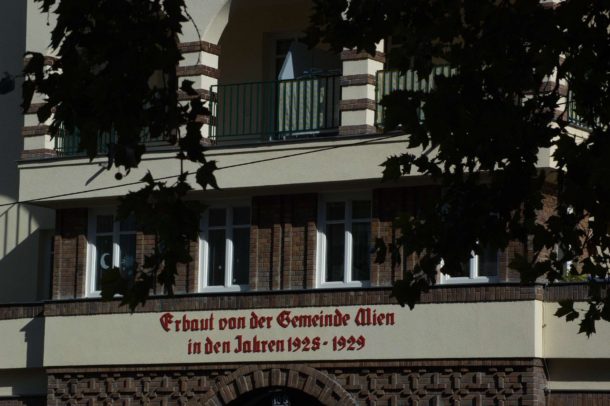The Housing Wonderland by Ian Lewis

Housing in Britain is broken. Everyone agrees, yet the discussion goes round and round the same narrow circle of choices. Nobody seems to realise that there’s no cosmic inevitability about things as they are. London gets another set of empty towers or a garden bridge (or not), not because of some abstract destiny, but because people – actual human beings – decide it shall be so.
ANOTHER WAY
And so, for a different approach to housing, I offer you the city of Vienna.
Vienna has a population of roughly 1.8 million – of whom approximately 60% live in social or subsidised housing. That’s not a misprint: more than half. The most important thing for the City of Vienna is that people should have good, truly affordable places to live. The British Way is not the Only Way.
BACKGROUND – RED VIENNA
Vienna’s approach has a long history. A bloodless revolution in November 1918 lead to the founding of the Republic of Austria. The Austro-Hungarian Empire, large though it was, had never been rich and the small area left after the Versailles treaty was poor and war-battered. The new government began in a spirit of co-operation, and for the first fifteen years of the new republic, was led by the socialist party. With Vienna, then as now politically to the left of the rest of the country, this became known as the time of Red Vienna.
One of the first things the city did was to begin building social housing – and many of the early projects are still there, with their dates of construction high on the walls. The first flats were small, but high quality, and were built around courtyards of green space – pleasant and open places to be. Schools and public laundries were often included, and even people who didn’t live there were encouraged to use them as thoroughfares.
They varied in size from buildings no larger than the tenements they replaced, to vast developments like the Karl Marx Hof, which stretches in a series of courtyards for over a kilometre along the river.
Red Vienna came to an end in the civil war of 1934, with the Austro-Fascist coup. But the policy was revived after the second world war and continues in the twenty-first century.
CENTURY TWENTY-ONE
And today? A recent front-page ad in a broadsheet newspaper in Vienna showed a happy family at home with the text, “Why is this family paying €700 rent instead of €1200? Because the City of Vienna does not sell land to commercial developers.”
As in much of Europe, it’s more usual to rent rather than buy, and most people live in flats. A quarter of the city’s population live in city-owned social housing, and another 35% in housing where the city has subsidised construction or renovation in order to keep rents low. Rents are controlled, and can only rise by a limited percentage each year, or with a new lease. It can be a relatively static market, with people living in the same place for years, or even generations. I have one friend who rents the same flat his great-grandparents first rented in 1910. A housing market is developing, but it remains comparatively small.
In 2003, Vienna said, “We need more housing,” and began building a whole new city quarter. The Seestadt Aspern, on a disused airfield (and Napoleonic battle ground) to the east of the city will provide (truly affordable) homes for 20,000 people, and jobs for nearly the same number.
A project new in 2017 will provide temporary (for up to ten years), no-deposit starter housing with quick-build structures. Forty per cent of each plot of land will be kept as green space.
EYES OF THE WORLD
Planners from Seattle visited Vienna in 2017 ( http://cityobservatory.org/housing-policy-lessons-from-vienna-part-i/) and concluded that Vienna is doing everything right, where Seattle is not. Vienna is providing high-quality, high-density housing with lots of green space, and with an efficient public transport system that encourages people not to use cars. Seattle sprawls and leaves no alternative but to drive everywhere.
British orthodoxy would say that this is a lovely idea but not realistic or sustainable. But it is sustainable, and shows a degree of long-term joined-up thinking unimaginable in twenty-first century Britain: housing with heating and air-conditioning piped to whole city areas from the energy generated by refuse incineration; public transport as part of the plan – the Underground line was extended to Aspern before the first people moved in. Of course Austria has its problems, too. But this shows what can be done if the will is there, and – much more important – shows that there are alternatives to the British mindset.
“This is an idea of a city,” I said once to a town planner, responding to his description of plans for his town. “A city is an idea,” he said.




 Visit Today : 6
Visit Today : 6 Visit Yesterday : 143
Visit Yesterday : 143 This Month : 3267
This Month : 3267